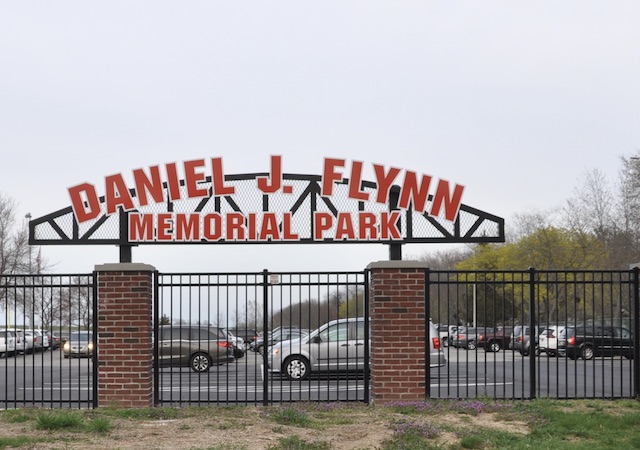News of Long Ago by Bradley Harris, Smithtown Historian
I have been writing about the descendants of Judge John Lawrence Smith and the impact that they have had upon Smithtown’s history. I have been tracing the story of Bessie Smith, the Judge’s youngest daughter who married Stanford White. Last week’s article was about Stanford White who became New York City’s leading architect and most famous citizen. This article deals with his illicit affair with Evelyn Nesbit and the tragic consequences that resulted.
“The dark side of Stanford White….”
“By the end of the nineteenth century, Stanford White was New York’s most famous citizen” and he had become ”the city’s leading architect.” Turn of the century newspapers regarded “the activities of Stanford White as ‘good copy’” and were constantly reporting his comings and goings. “All accounts agreed on his generosity – his donations of designs for monuments, his open-handed loans to artists, his care for the unfortunate, and all reports made clear his energy seemed to provide an almost inexhaustible reservoir which served him in both work and play. That he loved to play was never questioned – he adored beautiful girls and extravagant parties, and there were many parties. White played host constantly for his friends, and his parties were often spectacular.” Some of his parties were private affairs held in “White’s tower” atop Madison Square Garden. (Michael Macdonald Mooney, Evelyn Nesbit and Stanford White, Love and Death in the Gilded Age, William Murrow and Company, Inc., New York, 1976, p. 27-31.)
To these parties, White invited a “glittering list of the wealthy and powerful, the talented and successful. Stanny’s ‘celebrities’ were the ranking artists mixed with the important figures from both Broadway and Fifth Avenue” and White “was very cautious about” publicizing these private parties. “The food was always sent over from the exclusive Manhattan Club” and “the waiters had their instructions to leave food in the kitchenette” and “they were never permitted to see the guests. Stanny passed the champagne himself, and there were always showgirls to help.” Many of these showgirls came from the cast of ‘Floradora’ which was playing in the Casino Theater conveniently located next to White’s tower. And it was in the spring of 1901 that Evelyn Nesbit joined the cast of the musical and it was on stage that Stanford White first saw her. (Michael Macdonald Mooney, Evelyn Nesbit and Stanford White, Love and Death in the Gilded Age, opt. cit., p. 54.)
From the moment he laid eyes on Evelyn Nesbit in the cast of “Floradora,” Stanford White decided he had to possess this stunningly beautiful girl and he carefully plotted how to do just that. Evelyn Nesbit had come to New York City with her mother in the spring of 1900. Mrs. Nesbit “desperately tried to get work as a clothes designer and then as a seamstress, but weeks went by in her futile search.” Evelyn then convinced her mother to let her seek work as an artist’s model and her natural beauty immediately secured her employment. She became a fashion model and photographs of Evelyn wearing “hats, gowns, shoes, stockings and sport frocks” appeared in the fashion pages of the Sunday World and Sunday American. Almost overnight , Evelyn’s image as a “beautiful model” showed up in magazines and newspapers. It wasn’t long before a theatrical agent approached the Nesbits suggesting that Evelyn think about appearing on stage. The agent arranged a meeting with the producers of “Floradora” and as the summer began, Evelyn joined the cast as a Spanish Dancer. And it was in this role that Stanford White saw her on the stage of the Casino Theater and immediately decided to see more of her. (Michael Macdonald Mooney, Evelyn Nesbit and Stanford White, Love and Death in the Gilded Age, William Murrow and Company, Inc., New York, 1976, p. 27-31.)
In August of 1901, Stanford White arranged to meet Evelyn Nesbit for lunch. He had Edna Goodrich, one of the voluptuous girls in the Floradora sexette, invite Evelyn to lunch to meet with “some of Edna’s ‘society’ friends.” After gaining her mother’s permission, 16 year old Evelyn accompanied Edna in a hansom cab that whisked them up Broadway to “West Twenty-fourth Street and stopped at an address in the loft district.” (Michael Macdonald Mooney, Evelyn Nesbit and Stanford White, Love and Death in the Gilded Age, opt. cit., p. 44.)
It seemed like an odd place for lunch with Edna’s society friends, but when they arrived, Edna ushered Evelyn in the door and up “several flights of stairs to the top landing.” At the top of the stairs, “a tall, redheaded man was waiting for them. He had a big smile, boomed a cheery hello, and introduced himself as Stanford White.” Stanford then ushered the two women into a “breathtaking room” that had been decorated in “different shades of red” with “heavy red velvet curtains that shut out all daylight.” The room was lit by indirect lighting that cast a soft light throughout. “There were tapestries and fine paintings on the walls, and Evelyn was startled by an exquisite nude, lit by one of the hidden lights from overhead.” In the middle of the room was an antique Italian “table set for four.” Clearly the surroundings had been designed to provide an intimate setting for lunch. (Michael Macdonald Mooney, Evelyn Nesbit and Stanford White, Love and Death in the Gilded Age, opt. cit., pp. 44-45.)
Edna took her hat off, sat down, and immediately made herself “at home.” Evelyn joined her, trying “to act as nonchalant as Edna was.” Almost immediately a second man “came up the stairs” and joined them. He was introduced as Mr. Reginald Ronalds and “he was very cheery and full of little jokes, but Evelyn thought he was disappointingly old and not a bit handsome like Mr. White.” Mr. White served his guests lunch from a portable cabinet that had been delivered by Delmonico’s. “The food was delicious and there was champagne on ice in a bucket.” Evelyn told them that she had never tasted champagne and “they said she should have no more than one glass. Everyone laughed a lot at nothing at all. Both men fussed over her, and their admiration, their frank gazes, made her feel grown up.” The luncheon came to an abrupt end when Mr. Ronalds, a stockbroker, said he had to return to his office. (Michael Macdonald Mooney, Evelyn Nesbit and Stanford White, Love and Death in the Gilded Age, opt. cit., pp. 45-46.)
When they were alone, Mr. White took the two ladies up stairs that led to a large open studio that occupied the top two floors of the building. “Busts, paintings, drawings were lying about, and there were etchings of nudes on the walls. At one end there was a gorgeous swing hanging from the ceiling on red velvet ropes, with green smilax wound around the ropes and trailing down from its red velvet seat.” Mr. White suggested that Evelyn try the swing out, and she immediately did so, swinging higher and higher each time. “Mr. White gave her extra pushes to help her fly” and Evelyn laughed with delight on every swing through the loft. (Michael Macdonald Mooney, Evelyn Nesbit and Stanford White, Love and Death in the Gilded Age, opt. cit., p. 46.)
When the party broke up, and the girls were getting ready to leave, Stanford White suggested to Evelyn that she “should visit his dentist” to fix a front tooth that “needed professional attention.” White said to Evelyn, “It’s your only defect, and it spoils your smile.” Then they were back in the hansom cab and taken home by Mr. White’s chauffeur. Upon returning to the dingy boardinghouse where Evelyn lived with her mother, “Evelyn told her mother that Mr. White was a handsome, charming, splendid man, thoughtful and kind, a brilliant conversationalist, and that he had an extraordinary magnetism.” Within a few days, a letter came from Mr. White asking Mrs. Nesbit’s permission for Evelyn to come to lunch again saying he would send a hansom cab to pick her up. (Michael Macdonald Mooney, Evelyn Nesbit and Stanford White, Love and Death in the Gilded Age, opt. cit., p. 47.)
This time, Elsie Ferguson, a young actress starring in The Strollers at the Knickerbocker Theater, came along. Again they went to White’s apartment where they were again joined by another man, a Mr. Thomas Clarke, who was “a very famous dealer in Chinese porcelains and antiques.” As far as Evelyn was concerned, Mr. Clarke who had white hair and walked with a cane, “was as old as Methuselah” and that pleased White who looked young in comparison. “Once again after lunch, Mr. Clark said he had to leave, and Elsie, Evelyn, and Mr. White climbed the stairs to the big studio. Once more Evelyn played with the red velvet swing.” As the girls were leaving, Mr. White again asked about getting her chipped front tooth capped and told Evelyn he would contact her mother about having the work done. (Michael Macdonald Mooney, Evelyn Nesbit and Stanford White, Love and Death in the Gilded Age, opt. cit., p. 47.)
Several days later, a letter from Mr. White arrived requesting that Mrs. Nesbit come see him regarding Evelyn’s tooth, and that led to her visit to Stanford White in his office. Mrs. Nesbit came away from this visit telling her daughter “that she found Mr. White utterly charming, and she soon sent Evelyn off to have her tooth fixed.” A week later, Evelyn and Mrs. Nesbit “moved from the boardinghouse on Twenty-second Street to the Audubon Hotel” directly opposite Madison Square Garden “where ‘Floradora’ was playing” in the Casino Theater. “Evelyn and her mother agreed that they were more comfortable at the Audubon than they had ever been.” And it was Mr. White’s generosity that made the move possible. (Michael Macdonald Mooney, Evelyn Nesbit and Stanford White, Love and Death in the Gilded Age, opt. cit., pp. 47-48.)
Having worked his way into Mrs. Nesbit’s good graces, Stanford White laid siege on Evelyn’s heart. He “sent flowers every day,” sent her a beautiful “English-tailored cloak in American beauty red,” and paid to have Evelyn’s brother Howard enrolled in Chester Military Academy outside Philadelphia, something for which Mrs. Nesbit was profoundly grateful since she was constantly fretting about her young son’s health and well-being. When Mrs. Nesbit expressed a wish to visit her son, Stanford White was only too willing to pay the cost of the trip. He even suggested that Mrs. Nesbitt take the time to visit her fiancée in Pittsburgh. And when Mrs. Nesbit expressed her concerns about leaving Evelyn alone in New York City, “Mr. White assured her it would be quite safe for her to go; he promised to look after Evelyn in her absence. Mr. White and Evelyn went together to see Mrs. Nesbit off on the train.” (Michael Macdonald Mooney, Evelyn Nesbit and Stanford White, Love and Death in the Gilded Age, opt. cit., p. 48.)
Taking care of Evelyn was something that Mr. White zealously anticipated. He had a Union Club cab pick her up each night after her performance and transport her to the Audubon Hotel across the street, making sure she got home safely. Then Mr. White had his chauffeur “bring Evelyn to the offices of his firm, McKim, Meade and White, at 160 Fifth Avenue” where White gave her a grand tour of the office showing her where and how architectural drawings were made. He even introduced her to Charles McKim, “his partner and dearest friend.” (Michael Macdonald Mooney, Evelyn Nesbit and Stanford White, Love and Death in the Gilded Age, opt. cit., p. 49.)
That same night, he had the driver of the Union Club cab bring Evelyn to meet him at the 24th Street apartment. “It was the first time she had gone there at night.” Stanford White had set the table for supper, but this time “just for two.” Stanford made sure she had several glasses of champagne. After supper, he showed her throughout the apartment and led her to a “tiny little room, no more than 10’ square, its walls and ceiling all made of mirrors, even the floor was like glass.” He sat her down on “an immense couch” and “left her there, returning in a moment, with a gorgeous yellow satin Japanese kimono embroidered with festoons of wisteria. While he went to get more champagne, she tried it on.” (Michael Macdonald Mooney, Evelyn Nesbit and Stanford White, Love and Death in the Gilded Age, opt. cit., p. 50.)
“They sat on the green velvet couch sipping more champagne, and Evelyn was thrilled by her own reflections and the sight of herself next to Stanny.” They left the room and Stanford took her to “a bedroom in the back.” The bedroom had been well prepared – “a log fire flickering in the fireplace,“ red velvet draperies carpeting the walls from ceiling to floor, “a four-poster bed draped with heavy velvet curtains,” and mirrors on the headboard, within the canopy, and on the wall. Stanford got her to lie on the bed to play with buttons that controlled mood lighting within the room, and she blacked out. That was all Evelyn recalled of events that night until she came to. (Michael Macdonald Mooney, Evelyn Nesbit and Stanford White, Love and Death in the Gilded Age, opt. cit., p. 50.)
When Evelyn regained consciousness, “she started to cry.” Stanny was lying there beside her, and he turned to her and petted her and kissed her, and said, ‘Don’t. Please don’t. It’s all over. Now you belong to me.’ He got up and put on a robe and gave her the yellow kimono, which had been tossed across the back of a chair. He removed the telltale sheets and took her to an armchair and held her on his knees and soothed her, and she quieted. He told her he would come to her again that afternoon,” but now in the wee hours of the morning, “he was going to drive her back to the Audubon” and he did just that. (Michael Macdonald Mooney, Evelyn Nesbit and Stanford White, Love and Death in the Gilded Age, opt. cit., pp. 50-51.)
“Evelyn would sometimes describe the night in the fall of 1901 ‘when she became a woman’ as a sweet dream, as if she were remembering a sixteen-year-old girl’s drama of a poor butterfly. But there would be other occasions when she would recall that night somewhat differently. It all depended on who her audience might be. She would claim that a man nearly fifty had drugged her with champagne or with an opiate in the champagne, which had a bitter taste. She would say she lost consciousness; that when she awoke and discovered she was no longer a virgin she began to scream. She would say Stanny came over and asked her to please be quiet and not make so much noise, that he had said, ‘It’s all over; it is all over.’” (Michael Macdonald Mooney, Evelyn Nesbit and Stanford White, Love and Death in the Gilded Age, opt. cit., pp. 50-51.)
But of course it wasn’t all over, it had just begun….
 Friday, November 22, 2013 at 11:43PM
Friday, November 22, 2013 at 11:43PM 





